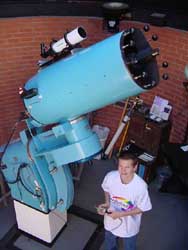Observing in the Southwest
Joan Hammel
I recently took a cross-country trip, ending in New Mexico and Arizona where I wanted to spend some time observing. A stop at the Rockhound State Park in Southwestern New Mexico warmed me up by showing me a sky full of stars without light pollution. It is amazing how much better the skies are there for viewing.
There are a number of opportunities out west for viewing. My wish to visit the Kitt Observatory was dashed when I learned that they do not have programs every weekend. Located about 60 miles southwest of Tucson, it supposedly has the world's greatest concentration of telescopes for stellar, solar, and planetary research. One of the best tips I can give is to call and check in advance as I did. Facilities' programs vary with some daytime, some nighttime programs and prices can be up to $60 per person.
 I decided that the best one for my trip was the Flandrau Observatory on the University of Arizona campus. Each night, a different scientist hosts a free program from 7 - 10 PM. You have the opportunity to look through "Blue Bell" (see photo) a 16-inch reflector. At some point, they are looking at upgrading this telescope to an even better one and selling this one for a pittance. They claim to have more of NASA's money for programs there than any other institution. Our scientist has worked on many missions, including Mars missions. She gave to me a number of information sheets that could become articles all on their own including general Mars information, the HiRise (High Resolution Science Experiment) and the Cassini Mission to Saturn. She also shared some amazing animations that were created from Hubble Telescope images including an inside view of Orion's Nebula. If you attend during the day, the Center has hands on exhibits, science demonstrations and a major national mineral display.
I decided that the best one for my trip was the Flandrau Observatory on the University of Arizona campus. Each night, a different scientist hosts a free program from 7 - 10 PM. You have the opportunity to look through "Blue Bell" (see photo) a 16-inch reflector. At some point, they are looking at upgrading this telescope to an even better one and selling this one for a pittance. They claim to have more of NASA's money for programs there than any other institution. Our scientist has worked on many missions, including Mars missions. She gave to me a number of information sheets that could become articles all on their own including general Mars information, the HiRise (High Resolution Science Experiment) and the Cassini Mission to Saturn. She also shared some amazing animations that were created from Hubble Telescope images including an inside view of Orion's Nebula. If you attend during the day, the Center has hands on exhibits, science demonstrations and a major national mineral display.
She stayed well past her 10 o'clock cut off, as some of us were so busy enjoying her presentation and asking questions. On the same campus, just a few blocks away, they have the Steward Observatory Mirror Laboratory. Mirrors created in this lab are used in the top observatories worldwide. You must call 10 days in advance for a tour of this facility. The most humorous thing about this facility is that it is located underneath the stadium. A really good tip for visiting these sites is that there are free parking passes that you can ask for from the front desk of the Flandrau, as parking on the campus is a premium. There is also free parking at the garage on Cherry Street after 6 PM.
Here are some other choices for star gazing from the Tucson info book:
1) Fred Lawrence Whipple Observatory: A joint venture of the Smithsonian Institution and the University of Arizona, this is real science. Named for the space science pioneer who founded it, it is generally known by its location: Mt. Hopkins. The 6-hour tour gives a narrated shuttle ride up to a 10-mile road to the working research center and observatory at the mountaintop with spectacular views at 8,500 feet elevation.
2) Mt Graham International Observatory: One of the country's newest observatory complexes. Mt. Graham is home to several renowned telescopes including the world's most powerful. Tour includes narrated shuttle ride up the scenic mountain, lunch near the summit, and a guided tour. Upon return, visitors can spend the evening touring Discovery Park. This includes a docent-lead tour of the Gov. Aker Observatory, a multi-media presentation and star gazing through the 20-inch telescope. www.discoverypark.com
3) Las Cienegas National Conservation Area, open country stargazing near Sonoita, AZ
4) Palominas Star Haven Observatory: located southeast of Sierra Vista: palominas.com
5) Astronomer's Inn: Watch the stars all night long near Benson, AZ where this unique bed and breakfast offers small and large groups an observatory and planetarium.
Published in the December 2006 issue of the NightTimes




